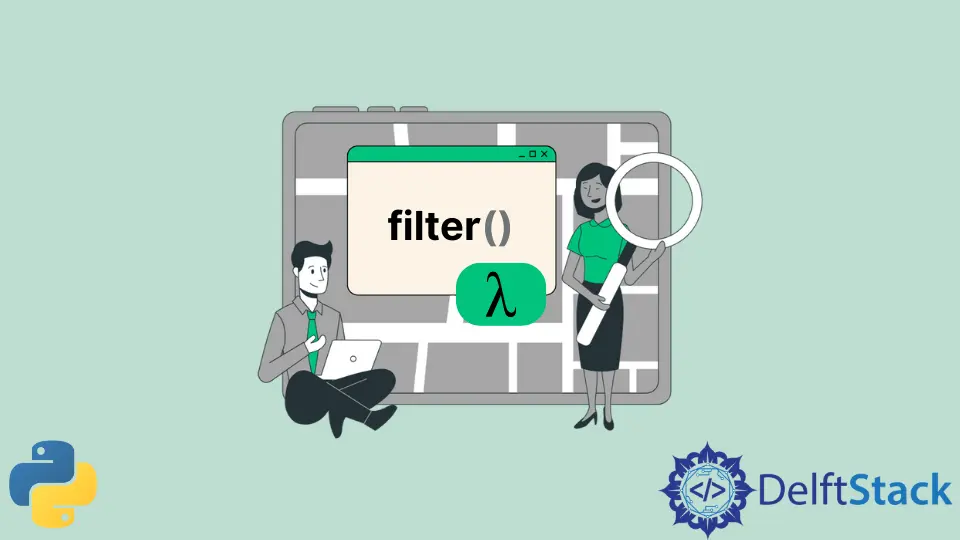The filter() Method and Lambda Functions in Python

Often, when working with iterable data structures such as arrays, lists, and tuples, we have to perform filtering operations over them.
Filtering refers to taking out the values that match a particular condition. One can perform filtering by iterating over the iterable data structure value and value using a for loop or a while loop and checking if the element satisfies the condition or not.
Since this is a common task, the Python programming language has an in-built method, filter(). This method needs a function to perform filtration. If you’re using filter() to check for None values, see [Check if a Variable is None in Python](HowTo/Python/check if variable is none python.en.md).
Generally, lambda methods are considered for this job since they are straightforward to write. This article will show how to use the filter() method and lambda functions together in Python.
the filter() Method and lambda Functions in Python
The filter method is an in-built method in Python programming language used to filter elements from an iterable that meet a certain condition. A function represents the condition, and the values for which the function returns True is considered in the result. If you want to usefilter() for extracting subarrays, check out our article on [Getting a Subarray of an Array in Python]({{relref ‘/HowTo/Python/python subarray.en.md’}}).
The filter() accepts two parameters; a function for filtering that returns a boolean value and an iterable object such as a list or a tuple. The filter() method is an iterator or filter object.
We must convert the iterator to a list or a tuple using the list() method or the tuple() method. The lambda functions inline and anonymous functions in Python.
These functions can be used along with the filter method.
The lambda functions have the following syntax.
lambda < parameters > : < expression >
Parameters should be comma-separated, and the expression should return a boolean result (True or False).
Let us understand how to use the two together using a simple example. Refer to the following Python code for the same.
array = [11, 23, 13, 4, 15, 66, 7, 8, 99, 10]
new_array = list(filter(lambda x: x <= 20, array))
print("Old Array:", array)
print("New Array:", new_array)
Output:
Old Array: [11, 23, 13, 4, 15, 66, 7, 8, 99, 10]
New Array: [11, 13, 4, 15, 7, 8, 10]
The above Python code filters all the values from the list of integer, array, that is less than or equal to 20.
Each value of the list is passed to the lambda function. If it returns True, the value is added to the result; otherwise, not.
Once the result is obtained in an iterator, it is converted to a list using the in-built list() method. Lastly, both the arrays are printed to the console.
Examples
Following are some examples to understand the usage of the filter() method and the lambda functions together.
Filter All the Even Numbers From a List of Integers
array = [1, 2, 3, 4, 5, 66, 77, 88, 99, 100]
new_array = list(filter(lambda x: x % 2 == 0, array))
print("Old Array:", array)
print("New Array:", new_array)
Output:
Old Array: [1, 2, 3, 4, 5, 66, 77, 88, 99, 100]
New Array: [2, 4, 66, 88, 100]
Filter All the Odd Numbers From a List of Integers
array = [1, 2, 3, 4, 5, 66, 77, 88, 99, 100]
new_array = list(filter(lambda x: x % 2 == 1, array))
print("Old Array:", array)
print("New Array:", new_array)
Output:
Old Array: [1, 2, 3, 4, 5, 66, 77, 88, 99, 100]
New Array: [1, 3, 5, 77, 99]
Filter All Strings of Length 5 From a List of Strings
array = [
"hello",
"python",
"world",
"walking",
"sleep",
"shelter",
"food",
]
new_array = list(filter(lambda x: len(x) == 5, array))
print("Old Array:", array)
print("New Array:", new_array)
Output:
Old Array: ['hello', 'python', 'world', 'walking', 'sleep', 'shelter', 'food']
New Array: ['hello', 'world', 'sleep']
Filter All the Numbers in the Range [10, 20] From a List of Integers
array = [11, 23, 13, 4, 15, 66, 7, 8, 99, 10]
new_array = list(filter(lambda x: 10 <= x <= 20, array))
print("Old Array:", array)
print("New Array:", new_array)
Output:
Old Array: [11, 23, 13, 4, 15, 66, 7, 8, 99, 10]
New Array: [11, 13, 15, 10]
Related Article - Python Function
- How to Exit a Function in Python
- Optional Arguments in Python
- How to Fit a Step Function in Python
- Built-In Identity Function in Python
- Arguments in the main() Function in Python
- Python Functools Partial Function
